Scientific Publication: Tracking the Spread of an Invasive Shrimp
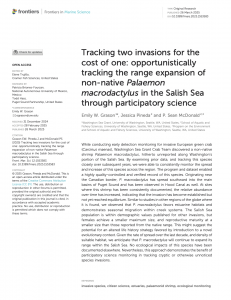 March 2025 – Crab Team made the first detection of, and systematically tracked, the range expansion of a non-native shrimp in the Salish Sea – Palaemon macrodactylus. Observations over the last decade across the Crab Team network suggest that this species is in a relatively early – and growing – phase of expanding its range. Read more in our Newsletter Deep Dive.
March 2025 – Crab Team made the first detection of, and systematically tracked, the range expansion of a non-native shrimp in the Salish Sea – Palaemon macrodactylus. Observations over the last decade across the Crab Team network suggest that this species is in a relatively early – and growing – phase of expanding its range. Read more in our Newsletter Deep Dive.
Citation: Grason EW, Pineda J, McDonald PS (2025) Tracking two invasions for the cost of one: opportunistically tracking the range expansion of non-native Palaemon macrodactylus in the Salish Sea through participatory science. Frontiers in Marine Science. Vol 12. https://doi.org/10.3389/fmars.2025.1553583
2024 Coastal Monitoring Site Summary
 January 2025 – An annual summary & analysis of the monitoring data from Crab Team’s monitoring sites in Washington’s coastal estuaries.
January 2025 – An annual summary & analysis of the monitoring data from Crab Team’s monitoring sites in Washington’s coastal estuaries.
2024 Monitoring Network Summary
 December 2024 – A visual summary of monthly (coastal & inland) monitoring and assessment trapping efforts during the 2024 monitoring season.
December 2024 – A visual summary of monthly (coastal & inland) monitoring and assessment trapping efforts during the 2024 monitoring season.
Scientific Publication: Do green crabs impact clam survival?
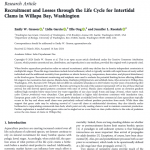 August 2024 – Crab Team collaborated with a team from UW Biology led by Jennifer Ruesink to examine patterns in recruitment of softshell and Manila clams in Willapa Bay, and explore whether survival of 1 and 3 year old clams might be impacted by the presence of green crab.
August 2024 – Crab Team collaborated with a team from UW Biology led by Jennifer Ruesink to examine patterns in recruitment of softshell and Manila clams in Willapa Bay, and explore whether survival of 1 and 3 year old clams might be impacted by the presence of green crab.
Citation: Grason EW, Garcia L, Ong E, Ruesink JL (2024) Recruitment and Losses through the Life Cycle for Intertidal Clams in Willapa Bay, Washington. Aquaculture Research. (1), 7411697. https://doi.org/10.1155/2024/7411697
Scientific Publication: Green Crab Diet DNA
![]() May 2024 – Researchers (including Crab Team’s Emily Grason, Alex Stote, and P. Sean McDonald!) looked at what green crabs collected from sloughs and clam beds in Willapa Bay were eating by exploring the DNA found inside their stomachs.
May 2024 – Researchers (including Crab Team’s Emily Grason, Alex Stote, and P. Sean McDonald!) looked at what green crabs collected from sloughs and clam beds in Willapa Bay were eating by exploring the DNA found inside their stomachs.
Citation: Fisher MC, Grason EW, Stote A, Kelly RP, Litle K, McDonald PS (2024) Invasive European green crab (Carcinus maenas) predation in a Washington State estuary revealed with DNA metabarcoding. PLoS ONE 19(5): e0302518. https://doi.org/10.1371/journal.pone.0302518
Scientific Publication: Larval Dispersal Pathways

April 2024 – A series of particle-tracking model simulations were carried out by researchers (including Crab Team’s Emily Grason and P. Sean McDonald!) to understand possible pathways of EGC larval dispersal from the Strait of Juan de Fuca into the Salish Sea.
Citation: Du, Jiabi, Carolyn K. Tepolt, Emily W. Grason, P. Sean McDonald, Yan Jia, and Weifeng G. Zhang. (2024) “Dispersal Pathways of European Green Crab Larvae into and throughout the Eastern Salish Sea.” Progress in Oceanography 223: 103245. https://doi.org/10.1016/j.pocean.2024.103245.
2023 Coastal Monitoring Site Summary
 February 2024 – An annual summary of the monitoring data from Crab Team’s monitoring sites in Washington’s coastal estuaries.
February 2024 – An annual summary of the monitoring data from Crab Team’s monitoring sites in Washington’s coastal estuaries.
2023 Monitoring Network Summary
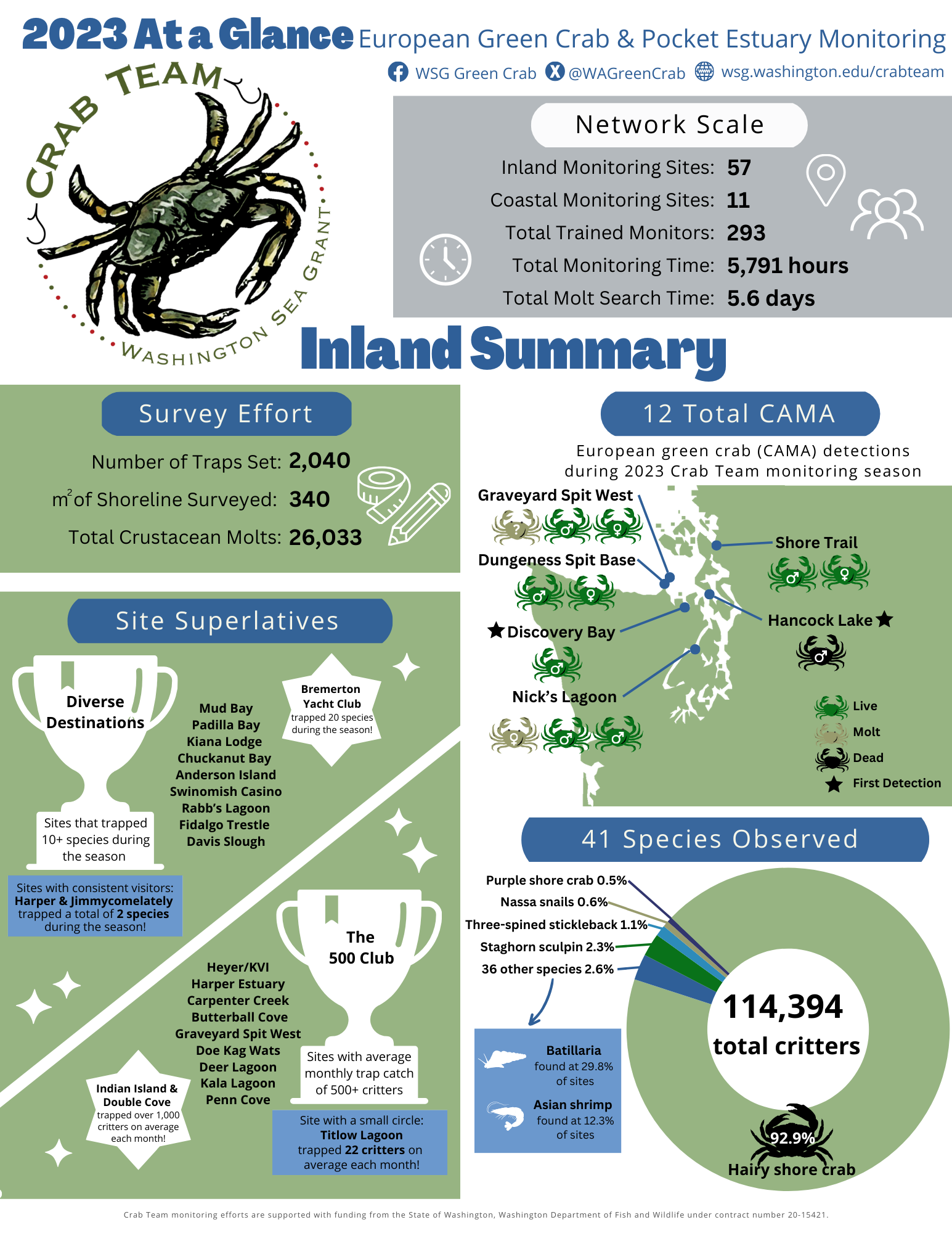 December 2023 – A visual summary of monthly (coastal & inland) monitoring and assessment trapping efforts during the 2023 monitoring season.
December 2023 – A visual summary of monthly (coastal & inland) monitoring and assessment trapping efforts during the 2023 monitoring season.
2022 Coastal Monitoring Site Summary
 March 2023 – An annual summary of the monitoring data from Crab Team’s monitoring sites in Washington’s coastal estuaries.
March 2023 – An annual summary of the monitoring data from Crab Team’s monitoring sites in Washington’s coastal estuaries.
2022 Monitoring Network Summary
![]() December 2022 – A visual summary of monthly monitoring and assessment trapping efforts during the 2022 monitoring season.
December 2022 – A visual summary of monthly monitoring and assessment trapping efforts during the 2022 monitoring season.
Technical Publication: Monitoring Site Selection
![]() August 2022 – The Crab Team process for site selection has been key to the many early detection successes in the Salish Sea. This report was the result of a technical working process within Fisheries and Oceans Canada to compare several methods of site selection and how they would perform across inland waters of British Columbia.
August 2022 – The Crab Team process for site selection has been key to the many early detection successes in the Salish Sea. This report was the result of a technical working process within Fisheries and Oceans Canada to compare several methods of site selection and how they would perform across inland waters of British Columbia.
Citation: Howard, BR, Gale, KSP, Davis, A, Lyons, DA, DiBacco, C, Grason, E, McDonald, PS, Green, SJ, Therriault, TW (2022) Evaluation of Methods for Identification of Early Detection Monitoring Sites Based on Habitat Suitability for Invasive European Green Crab in the Salish Sea, British Columbia. DFO Can. Sci. Advis. Sec. Res. Doc. 2022/057. vii + 54 p. (link)
Scientific Publication: Environmental DNA
![]() February 2022 – Abigail Keller, graduate student in the School of Marine and Environmental Affairs at UW validated an environmental DNA detection tool against traditional trapping-based efforts. How do traps compare? Read more in a series of blog posts
February 2022 – Abigail Keller, graduate student in the School of Marine and Environmental Affairs at UW validated an environmental DNA detection tool against traditional trapping-based efforts. How do traps compare? Read more in a series of blog posts
Citation: Keller, AG, Grason EW, McDonald PS, A Ramón-Laca, RP Kelly (2021) Tracking an invasion front with environmental DNA. Ecological Applications. Vol 32 (4):e2561. DOI: https://doi.org/10.1002/eap.2561
2021 Coastal Monitoring Site Summary
 February 2022 – An annual summary of the monitoring data from Crab Team’s monitoring sites in Washington’s coastal estuaries.
February 2022 – An annual summary of the monitoring data from Crab Team’s monitoring sites in Washington’s coastal estuaries.
2021 Monitoring Network Summary
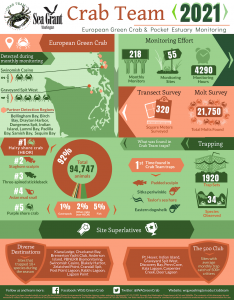 December 2021 – A visual summary of monthly monitoring and assessment trapping efforts during the 2021 monitoring season.
December 2021 – A visual summary of monthly monitoring and assessment trapping efforts during the 2021 monitoring season.
2020 Coastal Monitoring Site Summary
 January 2021 – An annual summary of the monitoring data from Crab Team’s monitoring sites in Washington’s coastal estuaries.
January 2021 – An annual summary of the monitoring data from Crab Team’s monitoring sites in Washington’s coastal estuaries.
2020 Monitoring Network Summary
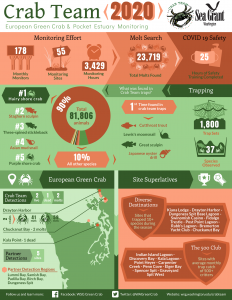 December 2020 – A visual summary of monthly monitoring and assessment trapping efforts during the 2020 monitoring season.
December 2020 – A visual summary of monthly monitoring and assessment trapping efforts during the 2020 monitoring season.
2019 Monitoring Network Summary
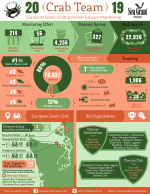 December 2019 – A visual summary of monthly monitoring efforts and observations during the 2019 monitoring season.
December 2019 – A visual summary of monthly monitoring efforts and observations during the 2019 monitoring season.
Scientific Publication: Larval Dispersal
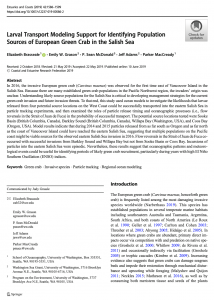 June 2019 – Elizabeth Brasseale, graduate student at UW Oceanography, used computer models of the ocean to help learn how green crab larvae could be moving into and around the Salish Sea. Read more about this project in our newsletter.
June 2019 – Elizabeth Brasseale, graduate student at UW Oceanography, used computer models of the ocean to help learn how green crab larvae could be moving into and around the Salish Sea. Read more about this project in our newsletter.
Citation: Brasseale E, Grason EW, McDonald PS, Adams J, MacCready P (2019) Larval transport modeling support for identifying population sources of European green crab in the Salish Sea. Estuaries and Coasts. Vol 42:1586-1599. DOI: https://doi.org/10.1007/s12237-019-00586-2
EPA Project Report – Phase 2
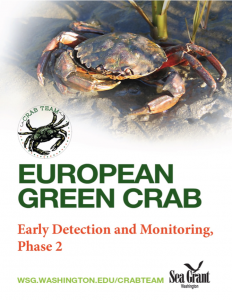 December 2018 – The 2018 season of Crab Team was funded by the US Environmental Protection Agency under assistance agreement PC 00J90701 to Washington Department of Fish and Wildlife. This document provides the final report and deliverables of the project, including a summary of findings from 2018.
December 2018 – The 2018 season of Crab Team was funded by the US Environmental Protection Agency under assistance agreement PC 00J90701 to Washington Department of Fish and Wildlife. This document provides the final report and deliverables of the project, including a summary of findings from 2018.
2018 Monitoring Network Summary
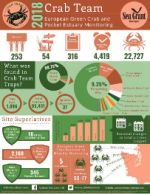 December 2018 – A visual summary of monthly monitoring efforts and observations during the 2018 monitoring season.
December 2018 – A visual summary of monthly monitoring efforts and observations during the 2018 monitoring season.
Scientific Publication: Range Expansion
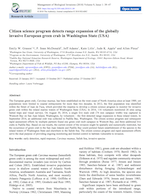 January 2018 – Crab Team’s first peer-reviewed publication, documenting the first European green crab confirmed on the Salish Sea shorelines of Washington State.
January 2018 – Crab Team’s first peer-reviewed publication, documenting the first European green crab confirmed on the Salish Sea shorelines of Washington State.
Citation: Grason EW, PS McDonald, J Adams, K Litle, JK Apple, A Pleus (2018) Citizen science program detects range expansion of the globally invasive European green crab in Washington State (USA). Management of Biological Invasions. Vol 9 (1): 39-47. DOI:https://doi.org/10.3391/mbi.2018.9.1.04
2017 Monitoring Network Summary
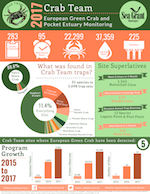 January 2018 – A visual summary of volunteer efforts and observations during the 2017 monitoring season and showing program growth since the 2015 launch.
January 2018 – A visual summary of volunteer efforts and observations during the 2017 monitoring season and showing program growth since the 2015 launch.
2016 Data Report
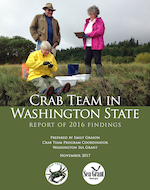 November 2017 – A closer look at Crab Team monitoring data from 2016. While Crab Team protocols search for evidence of European green crabs, the vast majority of data collected relate to native animals and habitats. In this report, we dive a little deeper into the seasonal and spatial patterns of abundance and diversity within the salt marsh and pocket estuary communities monitored across 26 sites along Washington’s inland shorelines. Available in high (5 MB) and low (1 MB) resolution
November 2017 – A closer look at Crab Team monitoring data from 2016. While Crab Team protocols search for evidence of European green crabs, the vast majority of data collected relate to native animals and habitats. In this report, we dive a little deeper into the seasonal and spatial patterns of abundance and diversity within the salt marsh and pocket estuary communities monitored across 26 sites along Washington’s inland shorelines. Available in high (5 MB) and low (1 MB) resolution
EPA Project Report – Phase 1
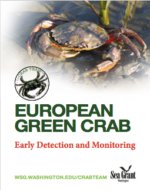 January 2017 – The first two years of Crab Team were funded by the US Environmental Protection Agency under assistance agreement PC 00J29801 to Washington Department of Fish and Wildlife. This document provides the final report and deliverables of the project, including a summary of findings from the first two years of the project, 2015 – 2016.
January 2017 – The first two years of Crab Team were funded by the US Environmental Protection Agency under assistance agreement PC 00J29801 to Washington Department of Fish and Wildlife. This document provides the final report and deliverables of the project, including a summary of findings from the first two years of the project, 2015 – 2016.
2016 Monitoring Network Summary
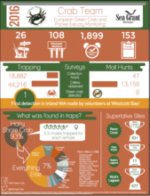 A visual summary of volunteer efforts and data gathered during the 2016 monitoring season. This was Crab Team’s first full season of monitoring (April – September), and the first year European green crab was captured in Washington’s inland waters.
A visual summary of volunteer efforts and data gathered during the 2016 monitoring season. This was Crab Team’s first full season of monitoring (April – September), and the first year European green crab was captured in Washington’s inland waters.
2015 Monitoring Network Summary
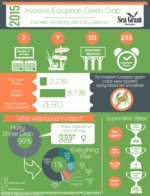 A visual summary of volunteer efforts and data gathered during Crab Team’s pilot season of monitoring, from August to September 2015.
A visual summary of volunteer efforts and data gathered during Crab Team’s pilot season of monitoring, from August to September 2015.